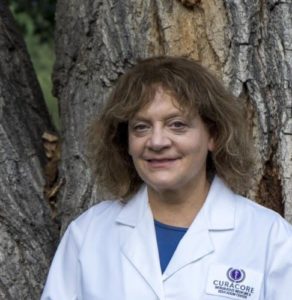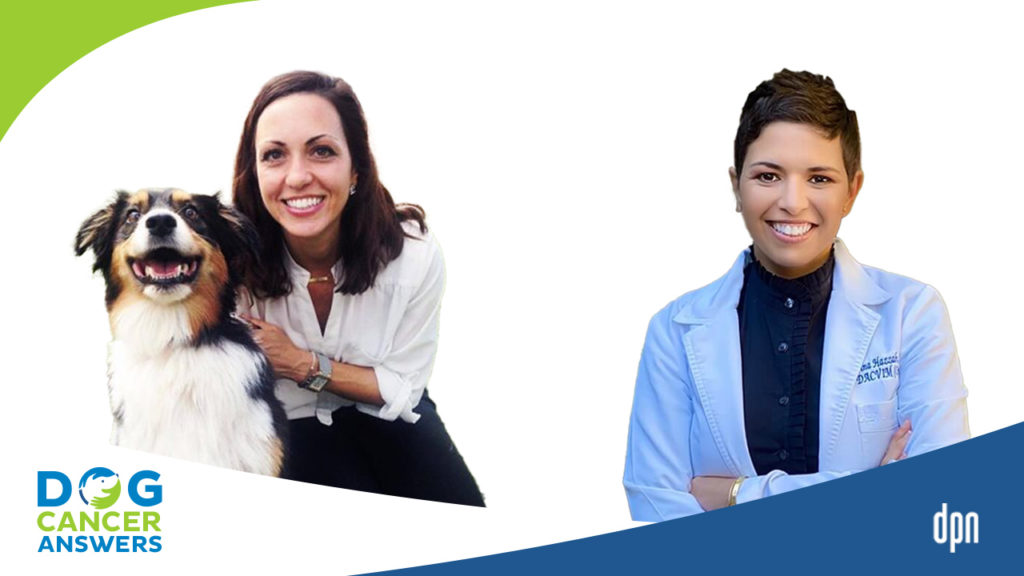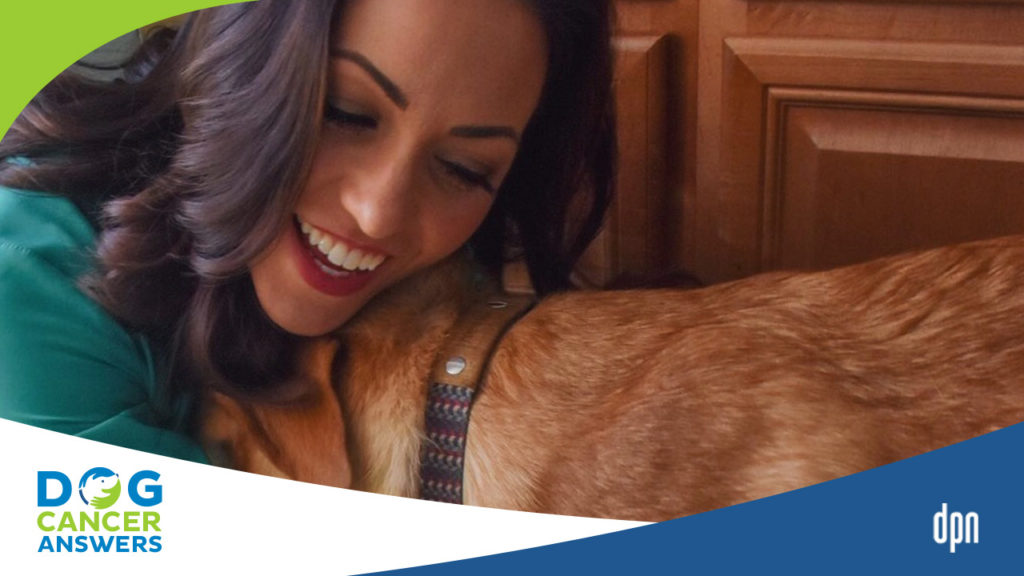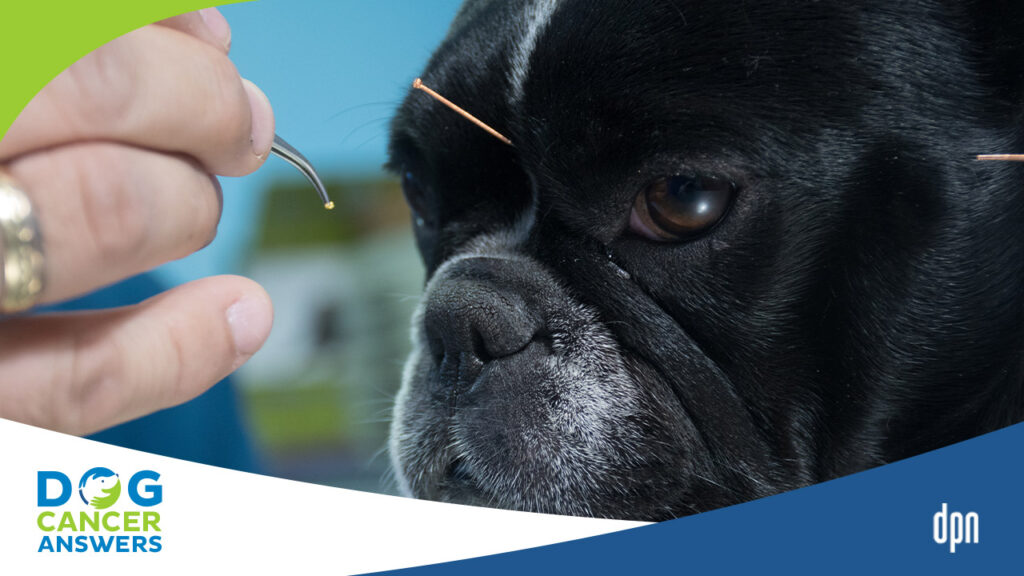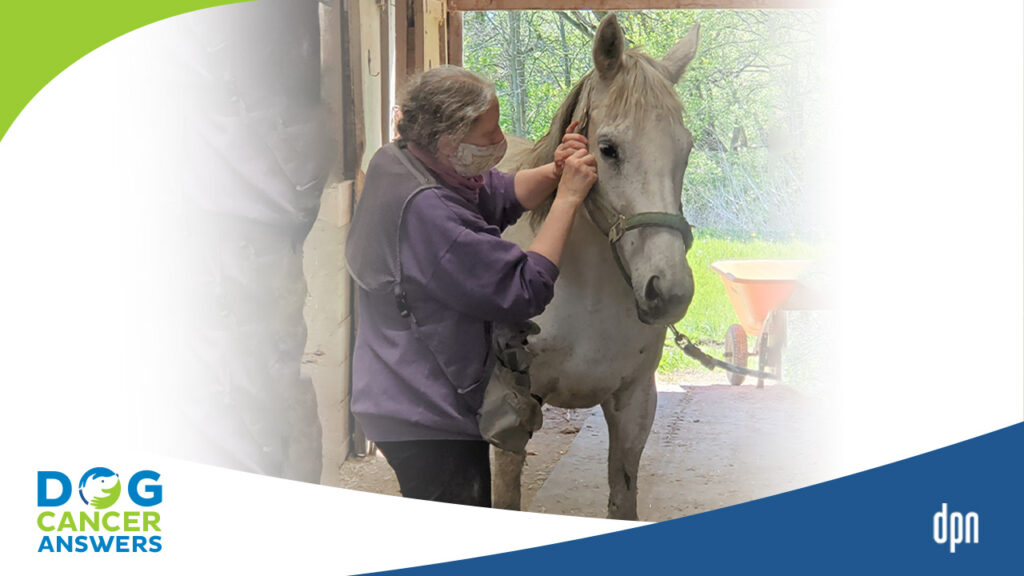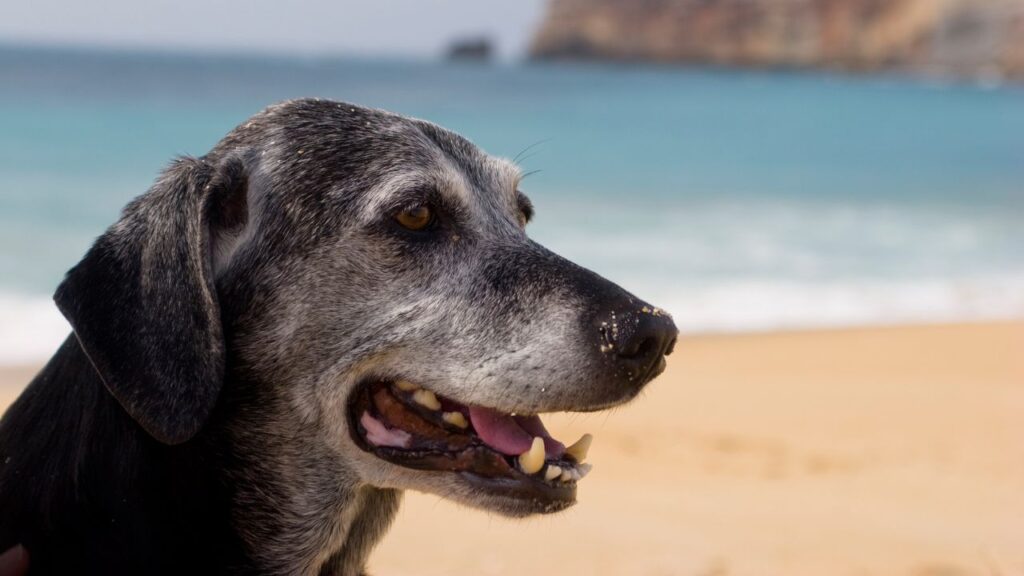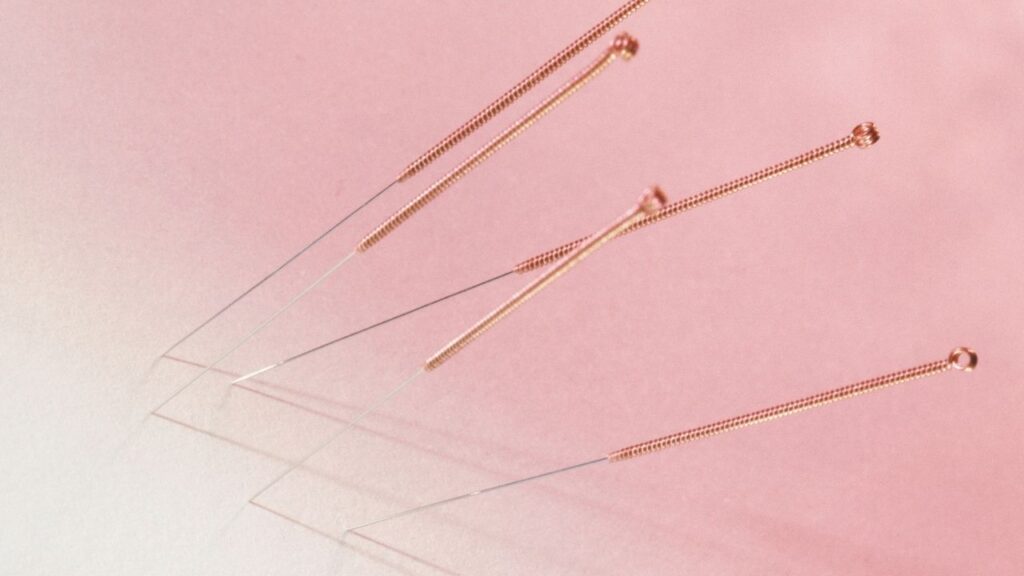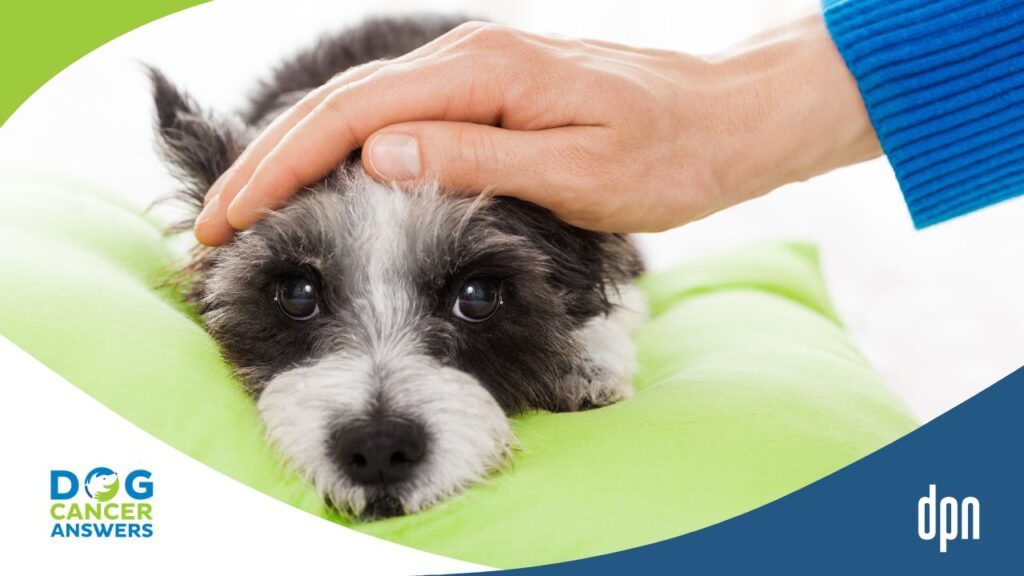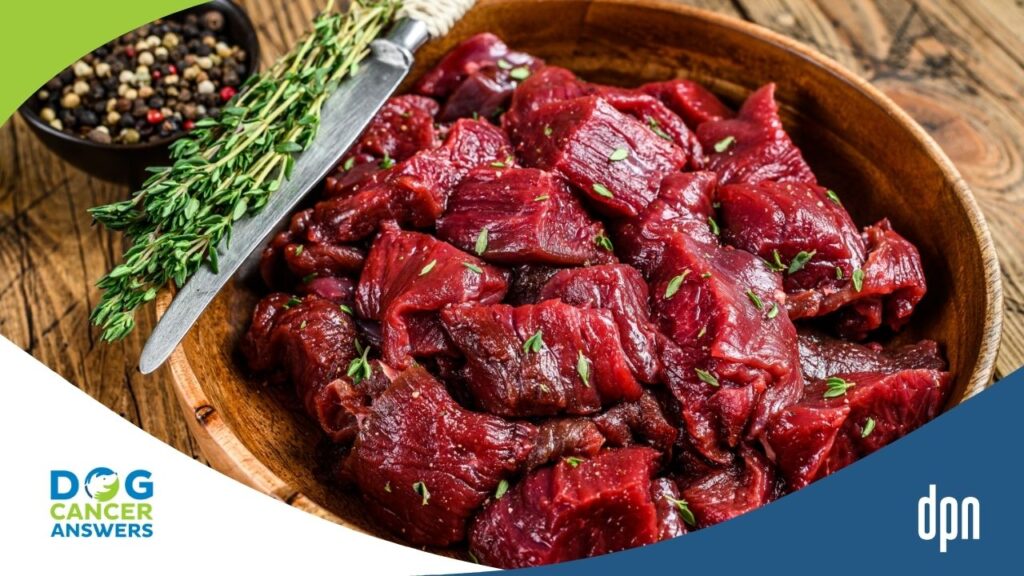EPISODE 203 | RELEASED February 13, 2023
Acupuncture for Dog Cancer | Dr. Narda Robinson
Can acupuncture cure dog cancer? Nope. But it can do a whole lot to help your dog feel better and alleviate side effects from illness and medications alike.
SHOW NOTES
Although there are many romantic ideas about where acupuncture comes from and how it works, the truth is rooted in science and anatomy. Acupuncture is the practice of applying tiny needles or pressure to specific areas to stimulate nerves and tissue to get the desired effect.
Dr. Narda Robinson is both a human doctor and a veterinarian, and she literally wrote the book on acupuncture points and what they do in the human body. In this episode, she explains how and why acupuncture works, as well as the specific ways that it can benefit dogs with cancer.
Short on time? Jump to about minute 42 to catch Narda’s rapid-fire myth-busting.
Links Mentioned in Today’s Show:
CuraCore Find a Practitioner https://curacore.org/vet/find-a-practitioner/
American Academy of Medical Acupuncture https://medicalacupuncture.org/
Narda’s Books: https://curacore.org/vet/bookstore/
[00:00:00] >> Dr. Narda Robinson: When it comes to something like cancer, a very common point is two thumbs up from the wrist crease in this hole here, and that’s right over one of those nerves I just mentioned, the median nerve. And that’s an anti-nausea point, which is really important for chemotherapy.
[00:00:19] >> Announcer: Welcome to Dog Cancer Answers, where we help you help your dog with cancer.
[00:00:25] >> Molly Jacobson: Hello, friend. Today on Dog Cancer Answers, we’re taking a deep dive into a really fascinating topic, acupuncture. All of the ways that it can benefit our dogs with cancer, and yes, it can help, and yes, it is rooted in science and medicine. To give us the nitty gritty, we’re joined by Dr. Narda Robinson. She is a doctor twice over. She’s also a previous professor at Colorado State University. She’s the president and CEO of CuraCore and literally wrote the book on acupuncture in humans.
Dr. Narda Robinson, thank you so much for joining us today.
[00:01:03] >> Dr. Narda Robinson: You’re welcome. Glad to be here.
[00:01:04] >> Molly Jacobson: Now, you’re a doctor a couple times. You have two doctor degrees. Could you explain a little bit about all the letters behind your name?
[00:01:13] >> Dr. Narda Robinson: Yeah, so my first doctorate was in osteopathic medicine. So I went the human route in part because, I don’t know, I just didn’t feel like I could handle veterinary medicine in terms of all the sort of sadness and everything.
And so I went the human route and preferred to go through osteopathic medicine rather than the MD way, which is allopathic medicine, just because my approach to things is much more like holistic in a way – that’s kind of an outdated word now, but just, with osteopathic medicine you look at structure and function and lifestyle and how we can work with our hands or use other methods to improve health.
And then I still wanted to work with animals, so then I went to Colorado State University and got my doctorate of veterinary medicine. I also did a master’s degree there. And the FAAMA is a Fellow of the American Academy of Medical Acupuncture, which is my human group. Just that’s the highest level of achievement with medical acupuncture as a board certified physician. So I think that’s kind of it.
[00:02:19] >> Molly Jacobson: All right. Well then you are well qualified to tell us all about acupuncture, how it’s used in animals, but specifically in dogs with cancer, and why this is a completely reasonable choice for people to make, even when there’s still a fair amount of skepticism about it, I would say, in the medical community at large. Which is waning, I think, but certainly I think in the future people are gonna understand a little bit more about why we may not know how this works exactly, but we do know that it’s has some benefit for folks. So where do you wanna start with all of that?
[00:02:56] >> Dr. Narda Robinson: Yeah. Well what happened over the decades that I’ve been doing acupuncture is that a lot has become known, and really the way it does work is through interaction with the nervous system and the connective tissue, so the muscles and the fascia and all that.
And I wrote a human book, it’s a seven and a half pound, actually, atlas of human acupuncture points based on the nerves and vessels and muscles that are associated with each point. And partway into that, I just recognized that every nerve that I was talking about that relates to an acupuncture point has certain functions associated with it.
And when I then wrote the section on the indications for each point, uh, it was just clear that the indications related either to the function of that nerve locally, or to the regional effects, or even to some kinds of reflexes that go through the brain stem and spinal cord and, you know, other parts of the brain.
So it really drove home the, just the idea – that others were suggesting to me, because originally I learned that it was about chi and invisible pathways and all this stuff, but there really isn’t any evidence that there is something like chi mystery kind of thing. And in fact, historically, we know that in China, that they recognized that they were stimulating anatomical structures way back when it was about blood vessels and bleeding.
But then over time, as needles were refined, they were just sending like nerve impulses into the body and having regulatory physiologic effects. So the way we’ve been teaching acupuncture for 25 years is strictly scientific, and in that way, we can identify objective outcomes that we’re looking for and understand which points or parts of the body or a whole protocol of acupuncture points, you know, will be the most effective at alleviating a given symptom or sign.
And you know, that’s where the acceptance of acupuncture is greatest, is when you can define the ways it works through science and pointing to evidence of effectiveness or the parts of the nervous system that are being engaged, and it becomes a much more reliable system in that way.
So, you know, I, I still am a human physician and licensed, I still have human patients. And then I taught at Colorado State University for about 20 years in the vet school. I started the medical Acupuncture for Veterinarians Program and the whole teaching activity about science-based integrative medicine.
So I worked closely with the animal cancer center there, which is a tertiary care cancer center, really leading edge, and consulted with clients and their animals, whether it was about supplements or using acupuncture or massage or whatever techniques we needed to do to help the animals with cancer. So there’s quite a diverse assortment of applications for acupuncture for patients with cancer.
[00:06:08] >> Molly Jacobson: So that’s really interesting. I wanted to, obviously wanna talk more about how to apply this to dogs with cancer. But first I wanna just go back to something you said earlier about stimulating nerves and muscle and fascia tissue. Now, because I used to be a massage therapist, I understand everything you just said, but I know that some of our listeners don’t even necessarily know exactly what nerves do.
Could you please explain why stimulating the nerves under the skin in a point on, I don’t know, the wrist, could have an effect on the brain that could have an effect on other parts of the body. Like how does that work exactly?
[00:06:54] >> Dr. Narda Robinson: Sure. Um, well, and I do have a little helper here.
[00:06:58] >> Molly Jacobson: Oh. For listeners who aren’t watching the video version, she has a stuffed dog.
[00:07:02] >> Dr. Narda Robinson: Yeah.
[00:07:02] >> Molly Jacobson: A
[00:07:02] >> Dr. Narda Robinson: stuffed dog.
[00:07:03] >> Molly Jacobson: What’s his name?
[00:07:04] >> Dr. Narda Robinson: Baxter.
[00:07:05] >> Molly Jacobson: Baxter, okay. This is Baxter.
[00:07:07] >> Dr. Narda Robinson: Yeah. So explaining how the nerves relate to physiology, you know, gets us to talk about a few different aspects of the nervous system. So with using Baxter or our own hands as, as demonstrations. So just the nervous system layout is that you have your brain, your spinal cord, and then you have nerves that come off of the spinal cord. And so all that is providing like sensation from like the body surface, but also in our viscera, so in our trunk, in our chest or heart, lungs, GI tract, and all that.
So all those organs inside and the muscles and the soft tissues on the outside, part of which are fascia, or that, that connective tissue covering, they are linked by the nervous system. So we have sensation going into the brain and spinal cord telling us where we are in space, you know, are we feeling pain, are we feeling heat or cold. And then there are nerves that then come out to our fingers and toes and all throughout the limbs.
And so in order for us to maintain just a balance, like what we call homeostasis, but day-to-day like temperature regulation, heartbeat, you know, just normality and even to stand up straight and use our muscles, all of that becomes a highly coordinated, highly orchestrated phenomenon from nerve impulses on the outside of our body that come into the spinal cord and into the brain. And there are just different centers that will receive that input, know where we are in space, are we gonna move forward with our right foot, what do we have to do in terms of muscle activation, adjust blood flow, all that. So, so much of that takes place even without our voluntary noticing. So it’s different than if we’re gonna play the piano.
And so there are just embedded pathways that help us maintain health, help counter inflammation, help relieve pain, and just so on – how we get through, you know, from the time we wake up till the time we go to sleep and then wake up again. All that is so complex.
But we’ve come so far, especially in the last century and now this century, in understanding how these nerves network with each other and how with acupuncture or massage that we can activate, I mean, stimulate or just activate impulses that then might turn around after they do their thing in the brain and help dampen like pain impulses from coming into the body.
So by taking a highly sophisticated approach to acupuncture, by knowing what different brain centers do, how points connect to the brain and different things, then we can design inputs that are proven with research and objective outcomes, you know, we can design inputs that will give us a reliable effect.
And for different cancers, for different pain problems, for different clinical applications, we know what normal is and how the body can regulate itself, but stress and pain and just the, you know, going through cancer treatment or having drugs, those will destabilize our balance. And that’s when we can use certain points that research has shown us that are reproducibly going to help restore balance and normality to the extent possible.
[00:10:40] >> Molly Jacobson: That’s amazing. Someone once told me – I’m not gonna say who they are – that acupuncture looks like just making someone into a pin cushion to him and he doesn’t think it has any meaning ’cause you could probably stick a pin in anywhere and it would have an effect on a nerve and then you could attribute that to that particular pin. So I know that you guys choose where you insert needles very carefully. I know there’s different depths and angles you can take. Was there any merit to what he said?
Could we stimulate activity no matter where we placed a pin – or a needle, I’m sorry, I keep calling it a pin because he said a pin cushion.
[00:11:22] >> Dr. Narda Robinson: Yeah, yeah, right.
[00:11:23] >> Molly Jacobson: He said, he called it that. But does it matter? Is it like if we throw a dart at a map, we might land on a road or we might land in the middle of a field, right? So does it matter where you insert your needle?
[00:11:35] >> Dr. Narda Robinson: Yes. I mean it does. And these are sterile needles, so it’s not like a pin cushion, but, but that’s-
[00:11:39] >> Molly Jacobson: Of course, right.
[00:11:40] >> Dr. Narda Robinson: -one of the different, I mean just, yeah. You know, I think that kind of statement, it’s easy to say and it demonstrates to me the lack of knowledge about acupuncture and the lack of curiosity and, a lack of intellectual curiosity about what’s going on here.
So there are kind of standard skeptic lines that, oh yeah, haha, isn’t that funny. But you know, again, if you’re approaching acupuncture scientifically, you know that that’s really off target. So for example, knowing – and this is why it took me 15 years to do my book, going through each of the 360 plus points on the human body, you know, it’s, that was human, and all the different layers.
So, each nerve, of course, does different things. So you know, listeners might not be aware of the different nerves, but radial nerve or ulnar nerve. I mean, even in one hand we have a nerve that supplies the skin of these fingers. The radial nerve.
[00:12:35] >> Molly Jacobson: Of the first three fingers.
[00:12:36] >> Dr. Narda Robinson: First three fingers. And of our fourth and fifth digit, we have a different nerve, the ulnar nerve. If we look at the palm, we have another nerve, the, the median nerve. And that also supplies some of these muscles. And so, even if you’re just a regular physician or veterinarian, if an animal comes in or a person comes in and they have some kind of nerve damage, it’s not that that nerve damage is the same as every other nerve damage.
It might mean that I can’t move my finger. It might mean that I can’t grip. If I damage certain nerves in my neck, I can’t hold my neck up straight. So each nerve has different actions and you have nerves that supply the soma or the muscles, you know, the outer layers that allow us to move to do the, all these things.
Then, I mean, even in our hand though too, on the video I mean you can see that there’s some redness there. With, with our hands and our feet, especially the palms and the soles of our feet, we have special nerves that are part of the autonomic or involuntary nervous system that help to thermoregulate. So, you know, we put on socks and we put on gloves to help keep heat in.
There are important reflexes from our hands and feet that go to our brain, and that the brain adjusts blood flow to our hands and feet based on, you know, our baseline level of our internal body temperature. So again, that’s part of all this regulation. And one certain point, like this point between the thumb and forefinger, but on the hand, on the back of the hand, large intestine four, it’s one of the four biggest points in the body. What is the significance of that versus any other site on the whole hand? This is a special portion of the hand that receives input innervation from every nerve that comes through the brachial plexus, which is the nerve network in your armpit.
So it’s supplied by the radial nerve, the ulnar nerve, the median nerve, and these autonomic blood vessel nerves that regulate temperature. So it’s a very powerful point because it has so much complexity of innervation. So it’s things like that, that once you understand how multi-layered the nervous system is, that why certain points do certain things.
When it comes to something like cancer, a very common point is two thumbs up from the wrist crease in this hole here. And so for people that have been on cruises, you know it’s just closer to your body from the wrist on the, the side where your palm is. And there’s a depression there, and that’s right over one of those nerves I just mentioned, the median nerve, and that’s an anti-nausea point, which is really important for chemotherapy.
[00:15:14] >> Molly Jacobson: Well, they sell bracelets. You can get them-
[00:15:16] >> Dr. Narda Robinson: They sell bracelets.
[00:15:17] >> Molly Jacobson: -in the store. That puts a little bump right over that point, right?
[00:15:21] >> Dr. Narda Robinson: That’s right. That’s right. Exactly.
[00:15:22] >> Molly Jacobson: Pericardium six.
[00:15:23] >> Dr. Narda Robinson: Right. Pericardium six. And that’s the-
[00:15:25] >> Molly Jacobson: I remembered.
[00:15:26] >> Dr. Narda Robinson: Good. That’s the anti-nausea point, and so people will use that on cruises, but you can also help reduce nausea. Using that like with chemotherapy, or especially it would be even more effective if we use electrical stimulation to each of those points. But why does a point near the wrist help you with nausea?
Well, it’s because of a lot of studies on humans and non-humans that shows that the median nerve accessed through here that’s stimulated when you have a needle or electrical stimulation there, that actually sends impulses to the brainstem – so that, the more reptilian part of your brain, I guess – and that adjusts the activity in the like vomiting center of your brainstem.
[00:16:12] >> Molly Jacobson: Aha. So it goes directly to the part of the brain that is in charge of whether you’re vomiting or not.
[00:16:20] >> Dr. Narda Robinson: Yes, yes. As well as other centers as well. But that’s where just, you know, dismissing acupuncture as every point does the same as every other point is just ignoring basic neuroanatomy that you learned the first year in vet school or med school.
[00:16:35] >> Molly Jacobson: Mm-hmm. Yeah. So do you consider this a rational approach to medicine or more intuitive, or a combination of those two?
[00:16:45] >> Dr. Narda Robinson: Well, I think all of medicine has a level of intuition to it, but this again is where as scientific medical acupuncture approach, it’s rational and it’s evidence informed, evidence-based. I mean, it’s like, let’s say with physical therapy. Let’s say we were doing transcutaneous electrical nerve stimulation. Let’s say we were doing, we were a neurologist and doing nerve conduction studies, or we’re a neurosurgeon and we’re putting in implanted electrodes to restore spinal cord function. I mean, all those things are impacting the nervous system.
So it’s not a foreign concept to use some way to stimulate or activate nerves. And I say activate because sometimes, like I said earlier, originally that we might initially stimulate something, but then we’re going to take down the activity just by the body’s own physiologic, you know, restoration of, of homeostasis and just recovery.
So nerve stimulation takes place all the time in different parts of medicine. That’s all acupuncture is. You know, it’s, it’s, is it’s not like exotic, it’s just stimulating fibers of nerves. But we’re also going into like, let’s say tight muscles, so trigger points, taut bands. So as a massage therapist, you know, you’re working them all the time.
[00:18:06] >> Molly Jacobson: Oh, yeah.
[00:18:06] >> Dr. Narda Robinson: And how acupuncture works is it helps to disrupt the incessant reflexes from the nervous system to the muscles that keep the body tight and keep it painful. So in addition to what we call neuromodulation, which is that balancing of the nervous activity where having connective tissue or soft tissue effects that are relaxing the muscles and all that covering, that connective tissue, like the webbing, like if you have corned beef – I’m a vegan, so it’s been like 50 years since I’ve even seen corned beef, but you pull it apart and there’s that webbing between those muscles that envelops their, I mean, that sometimes gets really tight. And with the acupuncture needle, it’s helping to relax that. So there’s a lot of pain benefits, both from the neural nervous system aspect and just the tissues themselves to help them let go.
[00:18:57] >> Molly Jacobson: Right. Obviously there’s a lot of trigger points that can develop right along, I can think of several that I’m very used to working that are also major acupuncture points, but I don’t know that I’ve ever mapped it out as closely as it sounds like you have over 15 years. I’m gonna make sure that your book is in the show notes so people can, uh.
[00:19:16] >> Dr. Narda Robinson: Thanks.
[00:19:17] >> Molly Jacobson: Pick it up.
[00:19:17] >> Dr. Narda Robinson: Sure. Yeah. Well, yeah, it’s seven and a half pounds so it’s hard for you to pick up, but yeah. It’s very extensive.
[00:19:23] >> Molly Jacobson: Workout with then.
[00:19:23] >> Dr. Narda Robinson: Thanks. Yeah, that’s true. So yeah. Actually, besides my work, even before I think, probably at least around the same time, there have been authors that have mapped out the overlap of acupuncture points to Janet Travell’s noted trigger points because, I mean the acupuncture pathways that some people call meridians but that’s actually a mistranslation, they occur along the, what we call myofascial cleavage planes, the places between the muscle groups where the nerves and vessels travel, or sometimes actually in those muscle belly areas, which are where oftentimes the trigger points are ’cause that’s where the nerve enters the muscle, and that’s where it can get really tight.
[00:20:05] >> Molly Jacobson: Oh, that’s really interesting. So here’s what I wanna know, our listeners are always looking for something they can do tonight at home to help their dog. I wanna know if there are any points that you could use your hands safely to help your dog at home. And then I also wanna know who I should hire to, uh, consult with for my dog’s acupuncture treatments.
[00:20:29] >> Dr. Narda Robinson: Yeah. Okay. Well, in terms of what people can do at home, I prefer to have people start with massage. And – I mean, we also teach medical massage courses at CuraCore. But with that though, I also like to teach my clients, if they’re motivated to learn, about palpation.
So just like when you would start to work with somebody, you’re gonna feel with your whole hand, not pokey fingers, you’re gonna feel where are they tight, where might there be warmth, where are they maybe protective. And whatever kind of disease process you’re going through or just day-to-day stresses, it’s just nice to have somebody have their hands – I mean, I know you know this – have their hands gently on you and just kind of combine with the tissue, blend in, and read the tissues with your hands and let the patient or your animal tell you, okay, where is it that they need help. And so often it’s the head and neck or the back, and sometimes they’re too tight and sometimes they’re kind of weak.
And so that’s where I would talk to people and show them a few techniques and then identify areas where that would work. And actually, I had written, it was published right before my human book, so 2015, I think it’s out of print now, but it was a canine medical massage book from the-
[00:21:48] >> Molly Jacobson: Oh.
[00:21:48] >> Dr. Narda Robinson: Yeah, from the Journal of the American Animal Hospital Association. And we did a number of videos and they might still be on the web. Just about effleurage, so the gliding technique, and, uh, petrissage, so a little bit of kneading. And I think I taught compression. So just gentle techniques. And while acupressure is a nice approach, I think massage is more important in terms of giving comfort to the animal and keeping that bond strong.
[00:22:17] >> Molly Jacobson: And when you work in a more general way where you’re not thinking about specific points, you are, yes, connecting with the dog, but you’re also addressing lots of points that you don’t have to think about. You don’t have to intellectually understand everything you’re doing in order to have a positive benefit. As long as you’re never, like, I get worried about people who use too many fingers and go too hard.
[00:22:42] >> Dr. Narda Robinson: Oh, yeah. Yeah. And that’s, that’s where even with veterinarians, I mean, I have to teach them to unlearn how they’ve been taught to palpate animals, and use pokey fingers, and press too hard.
[00:22:53] >> Molly Jacobson: Really?
[00:22:53] >> Dr. Narda Robinson: You have to start all over and just, you know, I’ll still have people start on their own neck or on their own body just to, just to get a feel for where the ropey bands are. So yeah, not pokey fingers, and not trying to cause pain, actually trying not to cause pain. But there is so much overlap between massage and acupuncture, just because we are, with both cases, helping things balance out and reducing inflammation, reducing stress and pain. It’s just that acupuncture does have that added little piece of being able to more precisely influence nerve function.
[00:23:29] >> Molly Jacobson: Sure. And possibly have a bigger effect, I’m thinking.
[00:23:32] >> Dr. Narda Robinson: Yeah, in certain ways have bigger effects for specific things. Yeah.
[00:23:38] >> Molly Jacobson: Okay. Let’s take a brief break now and then when we come back, I wanna get into the specifics of acupuncture for dog cancer.
And we’re back with Dr. Narda Robinson. So when I’m evaluating who should be doing acupuncture for my dog, what am I looking for as a layperson?
[00:24:00] >> Dr. Narda Robinson: Well, I mean, I promote a scientific approach. Because without that, especially for cancer, you know, having been in this field for so long, there are some myths out there like you should never treat a cancer patient with acupuncture because of, when you have the belief that you’re moving invisible energy and have no basis for it, then yeah, there are ideas that, oh, will we stimulate cancer if we stimulate blood flow, will I stimulate the energy of a tumor if I’m working along the same energy channel?
Then on the other hand, there are even beliefs that you can cure cancer with acupuncture in certain circles of the non-scientific world. And that’s, that’s not true. So I prefer that people see a scientific based acupuncturist who would recognize you’re not going to cause worsening of cancer just by stimulating blood flow.
That, I worked with one of the radiation oncologists at CSU and we were looking into doing a study actually on the benefits of more blood flow for patients with cancer. That makes the system more sensitive to chemotherapy and to radiation therapy. And you know, because it’s not about moving invisible energy along invisible lines, it’s about adjusting the nervous system, then the concept of, oh, I can’t work on the same energy line as the tumor because those, it’s not what we’re doing.
We’re helping the nerves and we’re helping give anti-inflammatory effects to animals, which are anti-cancer. And we’re just helping them have a better quality of life. So it’s always disturbed me when sometimes clients would eventually reach me and they said I, you know, I went where I live in New Mexico and you know, this person, they wouldn’t treat my dog because they said I can’t treat an animal with cancer with acupunture. Even though, especially in this one case I’m thinking of, where they were only looking for palliative care, hospice care, anyway.
So I think that staying within the realm of rationality and science is so vital. So for our course, we, we do have a website, CuraCore.org. So it’s C U R A C O R E.org. And on the vet side, not the human medical side, but the vet side, we have a place Find A Practitioner where we have thousands of graduates from our program.
So that’s where we have people from even around the world that have graduated from our course and that have the approach that I’ve taught. So that’s what I would suggest. I mean, there are other schools of thought, but again, I really encourage people to be, you know, looking for a rational approach.
[00:26:34] >> Molly Jacobson: Wonderful. So tell me some of the things that you can treat when it comes to dog cancer. Tell me how you use it, acupuncture, in dog cancer.
[00:26:44] >> Dr. Narda Robinson: Yeah, so overall, I think it’s important to have a supportive care approach when your animal is undergoing treatment for the cancer. Because it could be stressful, it could be uncomfortable, of course it’s expensive for the person, you know, a lot of times – chemotherapy and radiation – and it has consequences and there are side effects.
And so in terms of treating side effects, we had talked about nausea, and so inappetence from a dog or cat, and because of the physiologic effects of acupuncture when performed, you know, with this in mind, then we can help to improve appetite and relieve pain ’cause sometimes they won’t eat because they’re in pain.
So with our hands-on approach and palpation and just gentle, you know, really figuring out what’s going on and including massage to help with things and just getting an idea of whether that animal is experiencing the side effects of the cancer, of the treatment, or maybe it’s that they have neck pain because they’ve been stuck in a cage all day or they had a 12 hour ride.
[00:27:50] >> Molly Jacobson: Right. Maybe it’s not cancer.
[00:27:52] >> Dr. Narda Robinson: Yeah.
[00:27:52] >> Molly Jacobson: Maybe the problem is actually not the big problem you’re dealing with, but some small every day kind of thing that just gets conflated with the big cancer treatment.
[00:28:02] >> Dr. Narda Robinson: Absolutely. And you know, sometimes as, as you know, with like trigger point pathology, that can actually be worse for them than the cancer itself. And so by establishing a treatment plan, what I used to do is I’d spend between 30 and 45 or 60 minutes with each patient and the client. And we’d sit on the floor in a nice room with lights lowered and I’d talk to the client. It’d give me plenty of time to talk to the client about what are your concerns how do you feel that, you know, Fluffy, whatever, is doing. And I’m watching the animal. I’m watching them move if they’re mobile, I’m palpating them, I’m doing some massage, and I’m just – you know, you mentioned intuition – I’m getting a sense of how are you doing? And it doesn’t have to be my preconceived, oh, I’m gonna treat them for nausea, they have elbow cancer, I’m gonna do this, that, and the other. It’s about seeing the patient as a whole and finding out how much they need, not doing too much, being connected with their experience, as well as the concerns of the parent. And, you know, ’cause that feeds in too, it’s a whole big thing. And so that sort of supportive care, you know, it, it’s a network for them to be in because otherwise they might just be dropping their animal off for oncology, this or that, and then taking them home and they’re not part of the process.
And then, you know, like you mentioned what can they do at home, we would talk about what can you do at home. In what ways, environmentally, you know, noise wise, should you be playing music therapy, should we keep it nice and quiet? In what ways can we help make this, you know, a survivable experience for everybody?
[00:29:47] >> Molly Jacobson: Okay. So it’s very, very individual. It’s not like there’s a certain protocol you use every time with every dog who has cancer. It’s really individual.
[00:29:57] >> Dr. Narda Robinson: I prefer that it be individual because of different comorbidities or as we said, things that they come in with. If I was doing a research study for the anti-nausea effects of acupuncture, then you’d have to keep that rigorously the same for the most part. And we might do, you know, a protocol, okay, I’m gonna do electroacupuncture before chemotherapy on both sides of their arms for that point. There have been studies of like the side effects or the reactions of radiation therapy.
So again, research studies, then you’re sort of, you’re sort of limited, but you could have some built in freedom. But like nasal adenocarcinoma for example, so cancer of the face, maybe in the nose and that they’re getting radiation to the face, maybe the head and neck or something, depends on where it is, then that’s a real miserable experience for dogs.
You know, so, so with certain studies, it’s like shown that if you either start a drug or acupuncture or something before the reactions really take hold, then you, you’ve gained that much more and you can intervene better and reduce pain better than if the nervous system is all upset and then you try to intervene.
So being proactive and having people on your side where you could say, you know what, I want to have the acupuncturist or whoever on staff so that we can just continue this care, we already have built up an effect. But like a lot of times there’s not enough that conventional medicine can offer, for example, when you have all that radiation reaction in the head and neck and then they have dry eye, they might have a dry mouth. And it’s with acupuncture, even on these points, you know, distally, so on the arms and legs.
[00:31:40] >> Molly Jacobson: Far away from where it is.
[00:31:42] >> Dr. Narda Robinson: Yeah. Because you don’t wanna be sticking needles in that area that’s had radiation.
[00:31:46] >> Molly Jacobson: Right.
[00:31:47] >> Dr. Narda Robinson: And so we can have effects indirectly that still help reduce the itching and the discomfort and all that, you know, the changes in mucus and salivation and tear production, everything like that. So that, that’s pretty significant. And then we can add things like electroacupuncture and other methods of stimulation.
[00:32:05] >> Molly Jacobson: So that’s really interesting. So you don’t just see it as a standalone help, but you also see it as very, very useful in conjunction with very conventional treatments. And you would like to see people maybe thinking about doing acupuncture before sessions and then after as a way to support the body so that it maintains – it sounds like to me what you’re saying is dogs could be more comfortable than they are and we don’t have good tools for increasing their comfort, and acupuncture is a good tool for that.
[00:32:39] >> Dr. Narda Robinson: Yeah, I, I mean, we, we have a bunch of tools in conventional medicine, but a lot of them involve medications that will have their side effects. I mean, certainly in the human realm, there’s opioids. Now there’s cannabis for some people, and there’s cannabis for some animals. Depends on where you live.
[00:32:55] >> Molly Jacobson: Depends on where your state is. Yeah.
[00:32:56] >> Dr. Narda Robinson: Yeah. But drugs, nerve blocks, whatever, I mean, they can only go so far and there are negative consequences to some of them. So why shouldn’t we, you know, introduce things that are safe and effective and then see how that patient’s responding and then go from there.
[00:33:13] >> Molly Jacobson: So are there side effects of acupuncture?
[00:33:16] >> Dr. Narda Robinson: The side effects to acupuncture, well, certainly from an anatomical perspective, by knowing the body and where things are – we don’t wanna put a needle into an organ.
[00:33:27] >> Molly Jacobson: Right.
[00:33:27] >> Dr. Narda Robinson: So we’ll not do that, or a big vessel. And so, you know, being medically, veterinarily trained, we know where those are. We don’t plunge things in.
[00:33:37] >> Molly Jacobson: You’re not gonna put a needle in the carotid artery. You know where the carotid artery is.
[00:33:41] >> Dr. Narda Robinson: Right.
[00:33:41] >> Molly Jacobson: You know how to avoid it, and there aren’t any points on it. So we’re all set.
[00:33:45] >> Dr. Narda Robinson: Right, right. And with cancer, we don’t want to, you know, put a needle in the tumor. Though there are some studies out of China that have actually used electroacupuncture in tumors to help just make them necrose or whatever, but that’s not what we do.
[00:33:58] >> Molly Jacobson: Right.
[00:33:59] >> Dr. Narda Robinson: Yeah. And so we don’t wanna seed any cancer, so we don’t wanna be around a tumor. And so usually, if they were on blood thinners, I mean, we’re gonna be cognizant of that, but again, you’re staying away from vessels, so that shouldn’t be a big deal. You just don’t wanna overtreat. And again, my approach is different from some of the others where, we’re very gentle.
We don’t cause pain or anything. Our needling is gentle because there’s enough fear and pain around, I mean, the, the more you stimulate, sometimes you can get a stronger effect, but you’re also having the consequence of contributing to just that fear and the, the agitation.
[00:34:35] >> Molly Jacobson: Right.
[00:34:35] >> Dr. Narda Robinson: So there’s, even with, yeah, physical exams from a veterinary medical standpoint, one of my mottos that I teach is, you don’t have to cause pain to find pain. So we don’t move joints to the ranges of, you know, the motion such that the animal cries out. It’s like your hands should be able to gently palpate and understand, and your observation of a thing should be able to put things into perspective.
So anyway, being integrative and not alternative, then we’re using, you know, we, we understand what the conventional or the regular approaches are, and we see how that can work with integrative options. So the, you know, herbs, acupuncture, laser therapy, massage, and so on.
But, thinking about – another thing I teach is matching the mechanisms of the disease with the mechanisms of healing. So if we scientifically know how acupuncture works and what the benefits are, then okay, we know acupuncture provides anti-inflammatory effects, muscle relaxation, a certain amount of tissue regeneration and repair.
So how can we bring that into this equation? What does this animal need of those things and how do we, how can we make that happen? And the thing is that, even though I mentioned herbal medicine, I mean we gotta be careful with supplements and herbs because they can cause herb-drug interactions. And so for example, so it’s a little bit off topic, but the beauty of acupuncture is you’re not adding anything pharmacologically active to the equation.
[00:36:04] >> Molly Jacobson: Right.
[00:36:04] >> Dr. Narda Robinson: Something like St. John’s Wort for example, which I’ve had people come in and say, oh, this really helps my animal with separation anxiety and wind up and anxiety of other kinds. Can, they’ll say to the student, can you give this to them before they have their radiation or whatever, and it’s like, that would be a really bad thing because St. John’s Wort causes herb-drug interactions such that it can significantly lower the amount of active drug circulating in the bloodstream.
[00:36:30] >> Molly Jacobson: Right.
[00:36:31] >> Dr. Narda Robinson: And so that kind of thing, it’s like you just drove 1200 miles to get here and yet because of this herb that you’ve been giving, you’re negating the effects of the pain medicine, of the anesthesia, of the chemotherapy. So again, that’s where physical approaches that aren’t gonna muck with the pharmacology of things, are, really stand out.
[00:36:51] >> Molly Jacobson: That’s wonderful. So it sounds to me like the bottom line is there aren’t really any side effects to worry about with acupuncture because you’re not drawing blood, it’s, the point of it is to stimulate nerves so that by definition you don’t wanna do too deep or too hard, or – it’s pretty non-invasive, even though it sounds invasive to people who don’t like needles. But, they’re tiny, right? They’re tiny little.
[00:37:15] >> Dr. Narda Robinson: Yeah.
[00:37:15] >> Molly Jacobson: Tiny needles.
[00:37:16] >> Dr. Narda Robinson: They’re tiny. I mean, it matters again what your technique is, ’cause you could get thicker needles, but our technique is very gentle. It’s about the diameter of a hair, a little bit wider. They come to a tapered point, so they’re, they’re sliding through the tissue, they’re not cutting it. So it’s not like a hypodermic needle that has a beveled end and is sharp and has a hole in it.
[00:37:34] >> Molly Jacobson: Right.
[00:37:34] >> Dr. Narda Robinson: These are just solid and comfortable. And our technique is, we usually use an insertion tube, it’s just a tap. And so because I am a physician, I’ll demonstrate that to my students that come on site to our school. So I can do it, there’s like, they won’t even feel it.
[00:37:49] >> Molly Jacobson: They won’t feel it.
[00:37:49] >> Dr. Narda Robinson: Yeah. I mean.
[00:37:50] >> Molly Jacobson: Dogs don’t feel it, do they? I mean, they.
[00:37:52] >> Dr. Narda Robinson: Well, they, they can, again, it matters where are you going. So if, let’s say they had a lot of tense neck pain, they might feel it more because you’re going into a tense area. But as long as your approach is calm and you’re quick and you’re integrating massage and stuff, it’s not a big deal. It’s like, oh yeah. That’s where it hurts. And, you know, and, and they’re, you’re getting it, you’re relieving it.
[00:38:12] >> Molly Jacobson: Right.
[00:38:12] >> Dr. Narda Robinson: And so that’s the big difference is that at CSU, when, when I would have patients waiting for me, I mean, you know, they were like running in place on the leash trying to get to the room instead of being afraid and wanting to go.
[00:38:27] >> Molly Jacobson: They’re like, it’s good in there.
[00:38:28] >> Dr. Narda Robinson: It’s good in there. And then if they came to another service but they were gonna use my room, or they were gonna go somewhere else, like it caused confusion. And if they went somewhere else but they were used to coming to my room, they’d be like, no, I wanna go that way. So.
[00:38:40] >> Molly Jacobson: Aww.
[00:38:41] >> Dr. Narda Robinson: I mean, animals are smart.
[00:38:42] >> Molly Jacobson: Oh yeah.
[00:38:42] >> Dr. Narda Robinson: And they understand. Yeah.
[00:38:43] >> Molly Jacobson: They do. They understand. And they also understand, for sure, what your intentions are when you touch them.
[00:38:49] >> Dr. Narda Robinson: Yeah.
[00:38:50] >> Molly Jacobson: You know, I’ve had my dogs look at me like, I really can’t believe you just touched me like that because don’t you, I mean, you know better than that, right? Like.
[00:38:57] >> Dr. Narda Robinson: Right.
[00:38:58] >> Molly Jacobson: Like I hurt there, mom.
[00:38:59] >> Dr. Narda Robinson: Yeah. They should be cared for carefully.
[00:39:02] >> Molly Jacobson: Yeah. So I have so many other questions. I hope you’ll come back and talk more in detail about medical massage.
[00:39:10] >> Dr. Narda Robinson: Oh, I’d love to.
[00:39:11] >> Molly Jacobson: I wanna know, you said earlier that meridian is the name of the pathways in acupuncture and that that’s a mistranslation. So I wanna know what the correct translation of meridian is from whatever the Chinese word is to English.
[00:39:26] >> Dr. Narda Robinson: Yeah. Well, the jing luo is what they talk about, but channel is a closer translation and you know, to us we think of maybe television channels or whatever, but it, it’s a pathway. So.
[00:39:36] >> Molly Jacobson: Like a channel in the, like a, you would cut a channel for water to flow through.
[00:39:41] >> Dr. Narda Robinson: Yeah. So again, the, the Chinese system was very anatomically based to the extent that they knew it. And they, some, there’s a myth like they would never cut open the human body. They cut open the human body all the time.
[00:39:52] >> Molly Jacobson: Okay.
[00:39:52] >> Dr. Narda Robinson: They, they knew the weights of organs. They studied it closely. They had great powers of observation. But it was in the early 1930s, there was a French banker that was in China and he, he was just fascinated with some of the arts and practices of acupuncture and stuff. And he was the one that translated the word chi into energy. And that was a mistranslation.
[00:40:13] >> Molly Jacobson: Oh no. So a French banker mistranslated a bunch, didn’t understand what he was talking about.
[00:40:19] >> Dr. Narda Robinson: Yeah.
[00:40:20] >> Molly Jacobson: See, why don’t people stay in their lane?
[00:40:22] >> Dr. Narda Robinson: I know. Well, the thing was, I know, the thing was that, that in that era, the early 1930s, he was thinking of this elan vital, like he wanted acupuncture-
[00:40:32] >> Molly Jacobson: Uh huh.
[00:40:32] >> Dr. Narda Robinson: -to have a more mystical, spiritual basis.
[00:40:35] >> Molly Jacobson: Right. This was a very important topic at the time.
[00:40:37] >> Dr. Narda Robinson: Yeah. Yes. And so even now if, I mean, I have various Chinese-American, Chinese-English dictionaries just to show my students, it’s like chi means air. Chi is what you pump up your bike tire with. Uh, but you know, it’s so exotic to think of, Ooh, we’re doing all these like shamanic things, or just very exotic. And it really did a disservice to acupuncture because it put it in this metaphysical realm.
And so that’s a lot of what I do and I’m passionate about and that’s part of writing this huge, you know, medical acupuncture anatomy atlas was to show no, let’s learn as much as we can about this marvelous system called, you know, anatomy and the nervous system.
[00:41:19] >> Molly Jacobson: The neuromuscular complex.
[00:41:21] >> Dr. Narda Robinson: Neuromuscular, yeah. And the, the different interactions. It’s endlessly fascinating. I don’t need magic to make this a special technique because there’s more-
[00:41:30] >> Molly Jacobson: It’s already magic. There’s magic in science.
[00:41:32] >> Dr. Narda Robinson: Yeah. Right. And we’re always learning more about the intricacies and, and you can never know enough. I mean, it’s just. But we know plenty. But it’s like, ooh, I’m curious. And the other thing is now that for at least humans, now that we have functional brain imaging so we can watch brain activity increase and decrease in real time – like when you’re getting an acupuncture treatment or something else is happening, now they can map out certain brain areas and we know, okay, certain points have, you know, these effects on the brain and they change as a disease recovers or something. So.
[00:42:06] >> Molly Jacobson: Wow.
[00:42:06] >> Dr. Narda Robinson: Again, that idea of all points are the same can be disproven again.
[00:42:12] >> Molly Jacobson: That’s great. Okay, so before we wrap up, I wanna hear, uh, just real quick, run through all the myths associated with acupuncture as fast as you can. Go Dr. Robinson.
[00:42:25] >> Dr. Narda Robinson: Well, okay. That it works by energy. That’s false. That acupuncture worsens cancer. That’s false. That the spleen has, you know, there’s different organs, that the spleen has things to do with digestion. No, that was a misinterpretation in terms of the pancreas. Oh, I don’t know. There’s so many. There’s the idea of the triple heater that it’s, it’s some kind of, again, mystical thing that you can’t define. Actually, it shows the thoracic, the abdominal region, and the pelvic regions. Just body compartments.
[00:42:53] >> Molly Jacobson: Just the compartments. Okay.
[00:42:55] >> Dr. Narda Robinson: Yeah. And this is the last thing, like the tongue and pulse diagnosis are reliable indicators of diagnoses. No.
[00:43:01] >> Molly Jacobson: Okay.
[00:43:02] >> Dr. Narda Robinson: That, that might be a little, a, a, a big intense thing to stop with, but I’m like one of the only people on the planet that has done an actual study on canine tongue diagnosis and shown, yeah, it’s not a reliable indicator of internal disease. And it’s not even for humans for whom it was designed to looking at the cracks, the coloration, the coating, and feeling the pulse.
It’s a primitive folkloric system, both of them. And maybe that’s the best they could do. But we cannot prescribe Chinese herbs or determine diagnoses based on like feeling the pulse. I mean, I could go on about it, but it’s just not reliable and we shouldn’t be perpetuating that.
[00:43:39] >> Molly Jacobson: Oh boy. I graduated from the Swedish Institute in New York City in 2001. Yeah. Right before the towers fell. And I have a whole cohort of people, we all learned shiatsu because you had to learn a western and an eastern modality in your associate’s degree length program. And we had to learn shiatsu and I learned a hundred percent of all of the myths. And we all sat there and said, how can this like very kind of mystical system be so pragmatic under our hands?
Do you know what I mean? Like, like the way we’re thinking about this doesn’t really match the way we feel it’s helping people. And you know, I saw someone for shiatsu for like a year in order to get uh support through a very serious health problem. And what happened in those shiatsu sessions was really powerful.
But I know it was the relaxation, and yes, the release of the nervous system so that it could seek homeostasis so it could rebalance itself and help me with this really big thing in conjunction with everything else. It was, I think, heat, honestly. I think if I hadn’t done that, I would still be suffering, if that makes sense.
[00:44:53] >> Dr. Narda Robinson: Yeah, no, I agree. And, and then.
[00:44:55] >> Molly Jacobson: Even though I was getting treatment.
[00:44:56] >> Dr. Narda Robinson: Yeah.
[00:44:56] >> Molly Jacobson: But it was the treatment worked because I was relaxing on such a deep level, and my body was able to seek homeostasis in general, the treatment was helping.
[00:45:06] >> Dr. Narda Robinson: The points, the approaches, I mean, because a lot of times they’re near autonomic or you know, high physiologically balancing areas. And I know as a physician, just even, let’s say this was my human patient, but you go up to somebody and you know, you take their pulse, and you just kind of meditate on it. I mean, I learned how to do all that stuff.
[00:45:25] >> Molly Jacobson: Well, sure. You had to for your degree, right? For your acupuncture training?
[00:45:28] >> Dr. Narda Robinson: Well, yeah, it was, it was mixed of TCM and French energetics and science, so it was all that, so.
[00:45:34] >> Molly Jacobson: Okay.
[00:45:34] >> Dr. Narda Robinson: And I, I mean, I practiced believing it was energy for quite a while, until I realized it wasn’t. I mean, even taking your own pulse, I mean, there’s a, a physiologic exchange or impact of even pressing on your artery. That alone is, is having an impact, you know, it changes your pulse rate, does a lot of things.
So it’s just like, you know, we don’t have to have that gap that we hope that all that is true and that we learn things by heart because we don’t have any other way to connect it to the science that we know.
[00:46:04] >> Molly Jacobson: Right.
[00:46:05] >> Dr. Narda Robinson: But it’s, it’s just nice to know actually what’s happening.
[00:46:08] >> Molly Jacobson: Yeah. Okay. So given that, when should acupuncture be avoided?
[00:46:14] >> Dr. Narda Robinson: I think if, if a patient is like too out of it, like under anesthesia too, it’s not gonna work that well. But I would, for the nasal adenocarcinoma patients, I would treat them before they fully emerge from anesthesia because they would be calm and still, and just not trying to rub their face on everything.
Like if an animal, let’s say, is super aggressive or fearful, you know, they’re gonna be too wound up to actually just absorb that kind of neuromodulatory effect. I, I mean, there aren’t that many instances that you have to worry about. Like pregnancy, we don’t usually worry about that with animals, I mean, but there’s no cases of miscarriage that have been reported or spontaneous abortion with acupuncture.
But there’s just enough in the literature that, yeah, could we stimulate uterine contractions with certain points, yeah, maybe in certain animal models that have been used. But hasn’t, I don’t know. So just medical legally we tend to avoid that in people.
[00:47:11] >> Molly Jacobson: Right, right, right. Just to be sure. Like we always like to say that, right, like hasn’t been tested in pregnancy.
[00:47:18] >> Dr. Narda Robinson: Right, right. But you, people get massaged all the time in pregnancy.
[00:47:21] >> Molly Jacobson: Yeah.
[00:47:22] >> Dr. Narda Robinson: So it’s kind of overlap.
[00:47:23] >> Molly Jacobson: Thank you so much, Narda, for coming on. I hope you’ll rejoin us and talk more about all of these amazing insights you have at the intersection of all of these pretty different medical modalities and um, your wealth of information. I really appreciate you coming on today to talk to us about acupuncture. Hope you’ll come back.
[00:47:44] >> Dr. Narda Robinson: Yeah, I’ll come back anytime.
[00:47:46] >> Molly Jacobson: Thank you.
[00:47:47] >> Dr. Narda Robinson: Thank you.
[00:47:49] >> Molly Jacobson: And thank you listener. Check out the show notes for the links and resources mentioned in today’s episode, and also be sure to check us out on YouTube. Subscribe there and also in your favorite podcast app so you never miss an episode or another interesting conversation.
I’m Molly Jacobson, and from all of us here at Dog Podcast Network, I’d like to wish you and your dog a very warm, Aloha.
[00:48:16] >> Announcer: Thank you for listening to Dog Cancer Answers. If you’d like to connect, please visit our website at dogcanceranswers.com or call our Listener Line at (808) 868-3200. And here’s a friendly reminder that you probably already know: this podcast is provided for informational and educational purposes only. It’s not meant to take the place of the advice you receive from your dog’s veterinarian.
Only veterinarians who examine your dog can give you veterinary advice or diagnose your dog’s medical condition. Your reliance on the information you hear on this podcast is solely at your own risk. If your dog has a specific health problem, contact your veterinarian. Also, please keep in mind that veterinary information can change rapidly, therefore, some information may be out of date.
Dog Cancer Answers is a presentation of Maui Media in association with Dog Podcast Network.
Hosted By
SUBSCRIBE ON YOUR FAVORITE PLATFORM
Topics
Editor's Picks
CATEGORY
